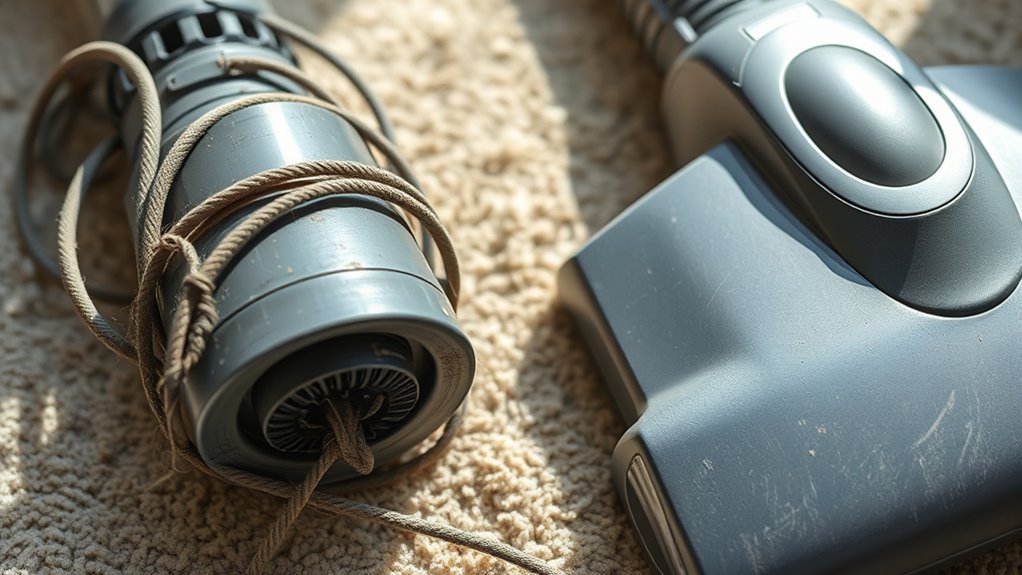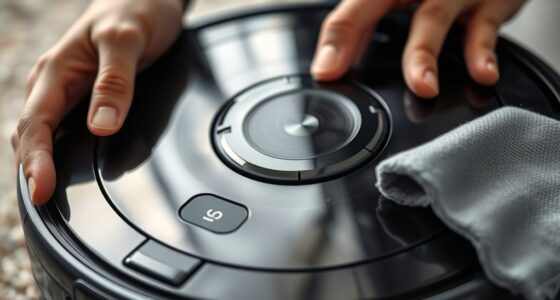Deciding whether to replace or repair your vacuum depends on factors like its age, warranty status, energy efficiency, and repair costs. If it’s still under warranty or repairs are cheap, fixing makes sense. But if your vacuum is old, costly to fix, or inefficient, replacing it with a newer model might save you money in the long run. To make the best choice, consider these factors carefully—you’ll find useful insights ahead.
Key Takeaways
- Prioritize repair if the vacuum is under warranty and repairs are inexpensive or free.
- Consider replacing if the vacuum is old, has frequent breakdowns, or repair costs are high.
- Upgrade to a new, energy-efficient model if your current vacuum consumes excessive power and is less effective.
- Evaluate if repair costs outweigh the benefits of a new vacuum with advanced features and better reliability.
- Use online resources to compare repair costs and warranty coverage to make an informed decision.

Deciding whether to repair or replace your vacuum cleaner can be tricky, especially when it starts acting up. You might wonder if investing in repairs is worth it or if a new model would serve you better in the long run. One key factor to consider is warranty coverage. If your vacuum is still under warranty, repairs could be inexpensive or even free, making fixing the issue a smart choice. However, if the warranty has expired, repairs might become costly, and it’s worth weighing whether those costs justify the age and condition of your machine. Additionally, newer models often come with more comprehensive warranties, giving you peace of mind and protection against future breakdowns.
Another important consideration is energy efficiency. Older vacuum cleaners tend to consume more power and may not clean as effectively, which can lead to higher energy bills over time. Replacing an outdated model with a newer, energy-efficient one can save you money in the long run. Modern vacuums are designed to use less electricity while providing superior suction and filtration, making them more environmentally friendly and cost-effective. If your current vacuum is outdated, the benefits of upgrading extend beyond energy savings—new models often come with advanced features like HEPA filters, better ergonomics, and improved maneuverability, enhancing your cleaning experience.
Upgrading to an energy-efficient vacuum saves money and enhances cleaning with advanced features.
When evaluating whether to repair or replace, you should also think about the cost and frequency of repairs. Small repairs, like replacing a belt or filter, are usually inexpensive and can extend your vacuum’s lifespan. But if you’re facing recurring issues or major component failures, those costs can add up quickly. Sometimes, investing in repairs makes sense if the vacuum is relatively new and has a solid warranty. Yet, if your machine is old, and repairs are piling up, it might be more economical to replace it altogether. Modern vacuums also tend to incorporate the latest technology, making them more reliable and efficient, which could reduce future maintenance needs. Moreover, the rise of online platforms and industry resources can help you find trusted repair services and price comparisons, aiding your decision.
Ultimately, balancing warranty considerations, energy efficiency, repair costs, and your vacuum’s age will guide your decision. If repairs are minor and your vacuum is still under warranty, fixing it makes sense. But if it’s old, energy-inefficient, or facing frequent breakdowns, replacing it with a new, energy-efficient model could be the smarter choice. Doing so not only ensures better cleaning and energy savings but also provides peace of mind with improved warranty coverage.
Frequently Asked Questions
How Long Should a Typical Vacuum Cleaner Last?
A typical vacuum cleaner lasts about 8 to 10 years with proper care. You’ll want to watch for signs like a weak vacuum motor or frequent belt replacements, which indicate it’s time to contemplate replacing it. Regular maintenance, such as replacing belts and cleaning filters, can extend its lifespan. If your vacuum starts losing suction or the motor struggles despite repairs, replacing it might be more cost-effective than repairing repeatedly.
Are There Eco-Friendly Repair Options Available?
Yes, eco-friendly repair options are available for your vacuum cleaner. You can choose eco-friendly parts made from sustainable materials and opt for sustainable repairs that reduce waste and energy consumption. Many repair shops now prioritize environmentally conscious practices, ensuring your vacuum gets fixed with minimal ecological impact. By selecting these options, you extend your vacuum’s lifespan, reduce waste, and support a healthier planet.
Does Warranty Coverage Influence Repair vs. Replace Decisions?
Warranty impact plays a significant role in your decision to repair or replace your vacuum cleaner. If it’s under warranty, repairs are often more cost-effective, saving you money. However, if the warranty has expired and repair costs are high, replacing might be the better choice. Consider cost considerations carefully—sometimes investing in a new, more efficient model can be more economical long-term.
Can Regular Maintenance Extend My Vacuum’s Lifespan?
Think of your vacuum like a car—you wouldn’t ignore regular oil changes. Regular maintenance, like replacing the vacuum filter and checking the cord, can substantially extend its lifespan. For example, I once cleaned my filter monthly and replaced a frayed cord early, and my vacuum kept going strong for years. These simple steps prevent breakdowns, saving you money and hassle, and keep your vacuum running efficiently longer.
What Are the Hidden Costs of Frequent Repairs?
Frequent repairs can lead to costly repairs and hidden expenses that add up over time. You might spend more on parts and labor than you’d initially expect, and ongoing repairs can cause your vacuum to become less effective, increasing your cleaning time and effort. These hidden costs often outweigh the price of replacing your vacuum, making it smarter to contemplate upgrading when repairs become frequent or expensive.
Conclusion
So, will you repair or replace your vacuum? Think about its age, performance, and repair costs. But beware—sometimes a small fix hides a bigger problem lurking beneath. The choice isn’t always clear, and the decision could change everything about your cleaning routine. Are you ready to take the risk? The answer might surprise you—just don’t wait too long before making it. Your next move could be closer than you think.









